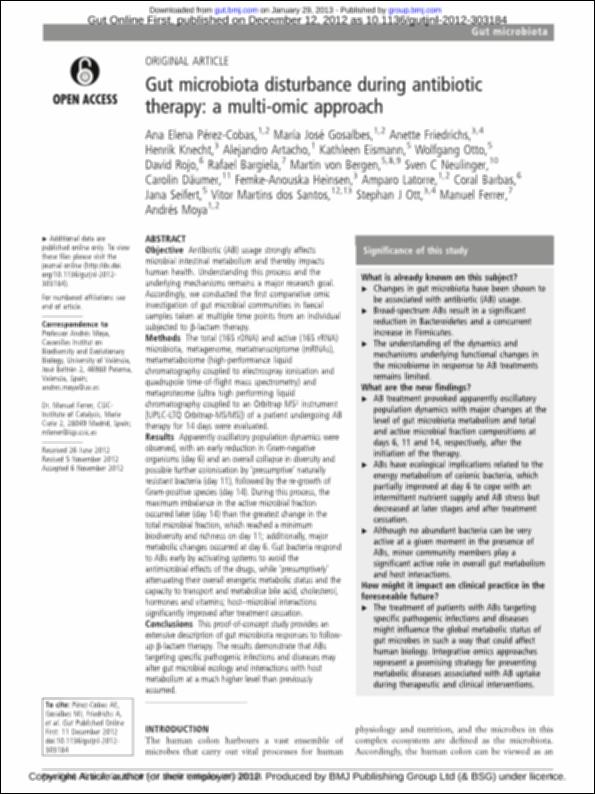Please use this identifier to cite or link to this item:
http://hdl.handle.net/10637/7657Gut microbiota disturbance during antibiotic therapy: a multi-omic approach .
| Title: | Gut microbiota disturbance during antibiotic therapy: a multi-omic approach . |
| Authors : | Pérez-Cobas, Ana Elena Gosalbes, María José Friedrichs, Anette Knecht, Henrik Artacho, Alejandro Rojo Blanco, David Barbas Arribas, Coral. |
| Keywords: | Metabolitos |
| Abstract: | Objective Antibiotic (AB) usage strongly affects microbial intestinal metabolism and thereby impacts human health. Understanding this process and the underlying mechanisms remains a major research goal. Accordingly, we conducted the first comparative omic investigation of gut microbial communities in faecal samples taken at multiple time points from an individual subjected to β-lactam therapy. Methods The total (16S rDNA) and active (16S rRNA) microbiota, metagenome, metatranscriptome (mRNAs), metametabolome (high-performance liquid chromatography coupled to electrospray ionisation and quadrupole time-of-flight mass spectrometry) and metaproteome (ultra high performing liquid chromatography coupled to an Orbitrap MS² instrument [UPLC-LTQ Orbitrap-MS/MS]) of a patient undergoing AB therapy for 14 days were evaluated. Results Apparently oscillatory population dynamics were observed, with an early reduction in Gram-negative organisms (day 6) and an overall collapse in diversity and possible further colonisation by ‘presumptive’ naturally resistant bacteria (day 11), followed by the re-growth of Gram-positive species (day 14). During this process, the maximum imbalance in the active microbial fraction occurred later (day 14) than the greatest change in the total microbial fraction, which reached a minimum biodiversity and richness on day 11; additionally, major metabolic changes occurred at day 6. Gut bacteria respond to ABs early by activating systems to avoid the antimicrobial effects of the drugs, while ‘presumptively’ attenuating their overall energetic metabolic status and the capacity to transport and metabolise bile acid, cholesterol, hormones and vitamins; host–microbial interactions significantly improved after treatment cessation. Conclusions This proof-of-concept study provides an extensive description of gut microbiota responses to followup β-lactam therapy. The results demonstrate that ABs targeting specific pathogenic infections and diseases may alter gut microbial ecology and interactions with host metabolism at a much higher level than previously assumed. |
| Description: | En: Gut. ESSN. 1468-3288. december 2012, doi:10.1136/gutjnl-2012-303184 |
| URI: | http://hdl.handle.net/10637/7657 |
| Rights : | http://creativecommons.org/licenses/by-nc-nd/4.0/deed.es |
| Issue Date: | 16-Sep-2012 |
| Appears in Collections: | Facultad de Farmacia |
Items in DSpace are protected by copyright, with all rights reserved, unless otherwise indicated.


